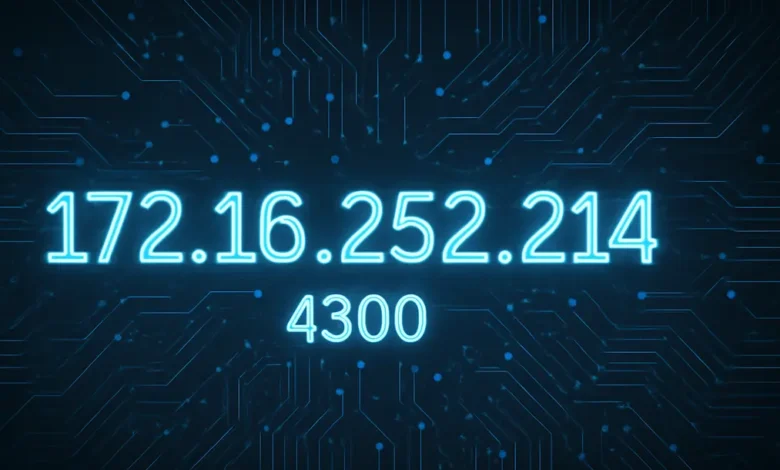When analyzing the media server configuration 172.16.252.2 14:4300, broadcast engineers and streaming professionals encounter a specialized multimedia infrastructure setup that typically involves video streaming servers, content delivery systems, or digital media platforms running on dedicated port configurations. This media network configuration represents essential broadcasting and streaming infrastructure that requires high bandwidth, low latency, and robust content management capabilities. Understanding 172.16.252.2 14:4300 requires exploring streaming protocols, media delivery systems, and the technical requirements of modern digital media distribution environments.
Streaming Media Server Architecture and Content Distribution
The IP address 172.16.252.2 within media streaming environments typically designates primary streaming servers, content delivery nodes, or media transcoding systems that manage video distribution and support live streaming, video-on-demand, and multimedia content delivery. This private IP addressing scheme provides network isolation while enabling high-performance media delivery and supporting scalable streaming architectures. The media server design ensures content availability while maintaining quality standards and performance optimization requirements.
Port 4300 in streaming environments often corresponds to proprietary streaming protocols, custom media applications, or specialized streaming services that require dedicated communication channels for optimal video quality and delivery performance. This port configuration supports media-specific communication requirements while enabling efficient content distribution and supporting various streaming protocols. The communication architecture ensures reliable media delivery while supporting scalability and quality optimization.
Live Streaming and Broadcast Systems Integration
Live streaming server configuration utilizing 172.16.252.2 14:4300 enables real-time video broadcasting, audience engagement, and interactive streaming capabilities through high-performance encoding systems and low-latency delivery protocols. These streaming platforms provide comprehensive broadcasting services while supporting multiple output formats and maintaining broadcast quality standards. The streaming implementation ensures live content delivery while maintaining viewer experience and broadcast reliability.
Broadcast automation and playout systems operating on port 4300 provide scheduled content delivery, automated programming, and broadcast control capabilities while supporting television broadcasting and digital media distribution requirements. These broadcast systems enable automated operations while maintaining programming schedules and supporting regulatory compliance. The automation ensures broadcast continuity while supporting operational efficiency and content management.
Video Encoding and Transcoding Services
Advanced video encoding and transcoding systems through 172.16.252.2 14:4300 provide multi-format video processing, adaptive bitrate streaming, and quality optimization that support diverse viewing devices while maintaining optimal video quality and bandwidth efficiency. This encoding infrastructure ensures content compatibility while supporting various delivery platforms and viewer requirements. The transcoding implementation ensures format flexibility while maintaining quality standards and delivery efficiency.
GPU-accelerated video processing and hardware encoding systems connected via port 4300 provide high-performance video compression, real-time encoding, and parallel processing capabilities that support high-volume streaming while maintaining encoding quality and operational efficiency. These hardware systems ensure processing performance while supporting scalable video operations and cost-effective encoding. The GPU acceleration ensures encoding efficiency while supporting high-volume operations and quality maintenance.
Content Delivery Network and Edge Distribution
Content Delivery Network (CDN) integration utilizing 172.16.252.2 14:4300 enables global content distribution, edge caching, and optimized delivery that reduces latency while improving viewer experience and supporting worldwide content access. This CDN architecture provides scalable distribution while maintaining content quality and supporting geographic load balancing. The CDN implementation ensures global reach while maintaining performance standards and viewer satisfaction.
Edge server deployment and content caching systems operating on port 4300 provide localized content delivery, bandwidth optimization, and improved response times while supporting high-demand content distribution and reducing origin server load. These edge systems enhance delivery performance while supporting scalability and maintaining cost-effective operations. The edge distribution ensures performance optimization while supporting global content delivery and bandwidth efficiency.
Adaptive Streaming and Quality Management
Adaptive bitrate streaming implementation through 172.16.252.2 14:4300 provides dynamic quality adjustment, bandwidth optimization, and seamless viewing experiences that adapt to network conditions while maintaining optimal video quality for diverse connection speeds. This adaptive technology ensures consistent viewing while supporting various network conditions and device capabilities. The adaptive streaming ensures viewer satisfaction while maintaining quality standards and network efficiency.
Quality of Service (QoS) management and traffic prioritization systems connected to port 4300 provide bandwidth allocation, traffic shaping, and network optimization that ensure reliable media delivery while supporting critical streaming operations and maintaining service level agreements. These QoS systems ensure delivery reliability while supporting performance guarantees and operational excellence. The quality management ensures service standards while supporting reliable content delivery and viewer experience.
Digital Rights Management and Content Protection
Digital Rights Management (DRM) systems utilizing 172.16.252.2 14:4300 provide content encryption, access control, and piracy prevention that protect intellectual property while enabling authorized content access and supporting content monetization strategies. These protection systems ensure content security while supporting business models and regulatory compliance. The DRM implementation protects content rights while enabling authorized distribution and revenue generation.
Content authentication and watermarking systems operating on port 4300 provide content verification, source identification, and anti-piracy measures while supporting content tracking and unauthorized distribution detection. These authentication systems ensure content integrity while supporting copyright protection and content owner rights. The watermarking ensures content traceability while supporting intellectual property protection and unauthorized use prevention.
Media Asset Management and Workflow Automation
Digital Asset Management (DAM) systems integrated with 172.16.252.2 14:4300 provide content organization, metadata management, and workflow automation that streamline media operations while supporting content discovery and operational efficiency. These management systems ensure content organization while supporting production workflows and operational productivity. The asset management ensures content accessibility while supporting workflow optimization and operational excellence.
Automated media workflow and processing systems connected through port 4300 provide content ingestion, automated processing, and delivery workflows that reduce manual operations while maintaining quality standards and supporting operational scalability. These automation systems enhance operational efficiency while supporting consistent quality and reducing operational costs. The workflow automation ensures operational efficiency while supporting scalable operations and quality maintenance.
Interactive Streaming and Real-Time Engagement
Interactive streaming platforms utilizing 172.16.252.2 14:4300 provide real-time chat, audience polling, and viewer engagement features that enhance streaming experiences while supporting community building and interactive content delivery. These interactive systems enhance viewer engagement while supporting social features and community development. The interactive implementation ensures engagement while supporting modern streaming expectations and viewer participation.
WebRTC integration and real-time communication systems operating on port 4300 provide low-latency streaming, bidirectional communication, and interactive features while supporting live streaming applications and real-time media delivery. These real-time systems enable immediate interaction while supporting modern streaming requirements and viewer expectations. The WebRTC implementation ensures real-time capabilities while supporting interactive streaming and communication features.
Analytics and Performance Monitoring
Streaming analytics and viewer metrics systems through 172.16.252.2 14:4300 provide audience insights, engagement tracking, and performance analysis that support content optimization while enabling data-driven decision making and operational improvement. These analytics systems provide operational intelligence while supporting content strategy and performance optimization. The analytics implementation ensures data insights while supporting strategic decision making and operational excellence.
Real-time monitoring and alerting systems connected to port 4300 track streaming performance, service availability, and quality metrics while providing immediate notification of issues and supporting proactive service management. These monitoring systems ensure service reliability while supporting rapid issue resolution and operational awareness. The monitoring capabilities ensure service quality while supporting proactive management and issue prevention.
Multi-Platform Distribution and Device Support
Cross-platform streaming delivery utilizing 172.16.252.2 14:4300 provides content distribution across smart TVs, mobile devices, web browsers, and streaming devices while maintaining compatibility and supporting diverse viewing preferences. This multi-platform approach ensures broad accessibility while supporting various viewing scenarios and device capabilities. The platform distribution ensures universal access while maintaining quality standards and viewer satisfaction.
Mobile streaming optimization and app integration systems operating on port 4300 provide mobile-specific delivery, app connectivity, and optimized viewing experiences while supporting mobile viewing patterns and bandwidth constraints. These mobile systems ensure mobile accessibility while supporting on-the-go viewing and mobile-specific requirements. The mobile optimization ensures mobile performance while supporting modern viewing habits and mobility requirements.
Monetization and Revenue Management
Video advertising and monetization platforms integrated with 172.16.252.2 14:4300 provide ad insertion, revenue tracking, and monetization strategies that support content monetization while maintaining viewer experience and supporting business objectives. These monetization systems enable revenue generation while supporting content business models and advertiser requirements. The advertising implementation ensures revenue opportunities while maintaining viewer satisfaction and content quality.
Subscription management and paywall systems connected via port 4300 provide access control, billing integration, and subscriber management that support subscription-based content delivery while maintaining security and supporting revenue management. These subscription systems enable content monetization while supporting customer management and revenue optimization. The subscription management ensures business sustainability while supporting customer satisfaction and retention.
Cloud Integration and Scalable Infrastructure
Cloud streaming services and elastic infrastructure utilizing 172.16.252.2 14:4300 provide scalable processing, global distribution, and cost-effective operations while supporting demand fluctuations and maintaining service quality. This cloud architecture enables operational flexibility while supporting cost optimization and scalable delivery. The cloud integration ensures scalability while supporting operational efficiency and cost management.
Microservices architecture and containerized streaming services operating on port 4300 provide modular streaming capabilities while supporting agile deployment and scalable operations that enhance operational flexibility and development efficiency. These modern architectures enable scalable streaming services while supporting development agility and operational optimization. The microservices approach ensures service modularity while supporting scalability and operational excellence.
Conclusion
The video streaming and media server configuration 172.16.252.2 14:4300 represents a comprehensive multimedia infrastructure that requires specialized expertise in streaming technologies, content delivery optimization, and media server administration to ensure reliable, high-quality video streaming services that support diverse viewing requirements and business objectives. This configuration enables various streaming applications from live broadcasting and video-on-demand to interactive streaming and enterprise video communications while maintaining the highest standards for video quality, delivery performance, and viewer experience. Whether supporting entertainment streaming, educational content delivery, corporate communications, or broadcast television, proper configuration and management of 172.16.252.2 14:4300 ensures streaming system reliability while maintaining quality standards and supporting organizational objectives through effective media server administration and streaming infrastructure management across diverse broadcasting environments and content delivery requirements.



